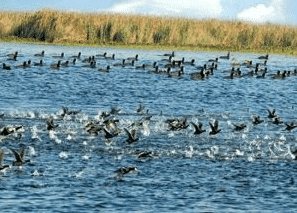Wildlife of Punjab | Punjab State (PPSC) PSC: Preparation - PPSC PCS (Punjab) PDF Download
Introduction
Punjab's landscape is predominantly agricultural, with most of the land converted for farming purposes. However, there are a few Wildlife Sanctuaries in the state where wild animals and plants can still be found. Some of the main wildlife species in Punjab include:
- Black Buck
- Chital (Spotted Deer)
- Hog Deer
- Blue Bull (Nilgai)
- Rhesus Monkey
- Wild Boar
- Langur Monkey
- Indian Mongoose
A Sanctuary is an area recognized for its ecological, faunal, floral, geomorphological, natural, or zoological importance. These areas are declared to protect, propagate, or develop wildlife and their environment. Human activities like timber harvesting and collecting minor forest products are also permitted in these sanctuaries. Some of the prominent Wildlife Sanctuaries in Punjab include:

Bir Aishwan Wildlife Sanctuary
Location and History. Situated 3 km from Sangrur city on Sohian road in the Sangrur district, this wildlife sanctuary was first notified in 1952. Area. The sanctuary covers an area of 2.64 square kilometers. Wildlife. The sanctuary is home to various species, including the jungle cat, blue bull, hare, jackal, peafowl, black and grey partridges, rose-ringed parakeets, and spotted owlet.
Bir Bhadson Wildlife Sanctuary
Location and History. Bir Bhadson Wildlife Sanctuary is located in Patiala and was originally preserved as a Shikargah, a hunting zone for rulers. It was declared a Wildlife Sanctuary under the Fauna of Patiala Act in 1952. Area. The sanctuary spans an area of 10.23 square kilometers. Wildlife. The sanctuary is home to various species, including blue bulls, hares, jungle cats, jackals, rhesus macaques, peafowl, black and grey partridges, rose-ringed parakeets, and spotted owlets.
Bir Bhunerheri Wildlife Sanctuary
Location and History. The Bir Bhunerheri Wildlife Sanctuary is located 15 kilometers from Patiala, along the Patiala-Devigarh road. It was established in 1952. Area and Vegetation. The sanctuary covers an area of 6.62 square kilometers. The predominant trees in the sanctuary are Shisham and Kikar. Wildlife Species. The sanctuary is home to a variety of wildlife, including:
- Hog Deer
- Blue Bull
- Porcupine
- Black Buck
- Sambar
- Jungle Cat
- Jackal
- Rhesus Monkey
- Peafowl
Bir Dosanjh Wildlife Sanctuary
Location and History. The Bir Dosanjh Wildlife Sanctuary is situated near Nabha town, along the Nabha-Jorepul road. Like the Bir Bhunerheri Sanctuary, it was also established in 1952. Area. This sanctuary spans an area of 5.18 square kilometers. Wildlife Species. The Bir Dosanjh Wildlife Sanctuary is home to various wildlife species, including:
- Blue Bull
- Jungle Cat
- Jackal
- Rose Ringed Parakeet
- Peafowl
- Black Partridge
- Grey Partridge
Bir Mehas Wildlife Sanctuary
The Bir Mehas Wildlife Sanctuary is located in the village of Mehas, near Nabha town along the Nabha-Malerkotla road. Established in 1952, it covers an area of 1.23 square kilometers. The sanctuary is home to various wildlife species, including rhesus monkeys, jungle cats, jackals, peacocks, and blue bulls.
Bir Moti Bagh Wildlife Sanctuary
- The Bir Moti Bagh Wildlife Sanctuary is situated about 5 kilometers from Patiala on the Patiala-Dakala road. Spanning an area of 6.54 square kilometers, it was once a prominent hunting reserve for the former rulers of the Patiala state. The sanctuary was declared a protected forest and later designated as a sanctuary under the Fauna of Patiala Act in 1952.
- A small zoo is located on the outskirts of this sanctuary. Main wildlife species found in this sanctuary are black buck, chital, hog deer, blue bull, wild boar, jackal, rhesus monkeys, peafowl, brahminy myna, black and grey partridges and quails.
Abohar Wildlife Sanctuary
- The Abohar Wildlife Sanctuary, covering an area of 186.5 square kilometers in the Firozpur district, is the largest wildlife sanctuary in Punjab. Established in 1975 and re-notified in 2000, the entire sanctuary is comprised of private farmlands owned by thirteen Bishnoi villages.
- This sanctuary is unique for wildlife conservation because the Bishnoi community has taken it upon themselves to protect the state animal, the black buck, which is sacred to them. The black buck, blue bull, and wild boar are among the mammals protected in this sanctuary.
Bir Gurdialpura Wildlife Sanctuary
Located 45 km from Patiala city along the Patiala-Samana-Shatrana road, the Bir Gurdialpura Wildlife Sanctuary covers an area of 6.20 square kilometers. It was designated as a protected forest and later as a sanctuary under the Fauna of Patiala Act in 1977.
The sanctuary holds significant ecological value and provides a suitable habitat for various wild animals.
Some of the main wildlife species found in the sanctuary include:
- Blue Bull
- Hog Deer
- Harl
- Jungle Cat
- Jackal
- Rhesus Monkeys
- Peafowl
- Black and Grey Partridges
- Dove
- Spotted Owl
Harike Wildlife Sanctuary
- Harike Wildlife Sanctuary is located where the Beas and Sutlej rivers meet, bordering the districts of Tarn Taran Sahib, Kapurthala, and Firozpur. This sanctuary was established in 1982 and covers an area of 86 square kilometers. It is home to a wide variety of mammals, fish, and birds. One of the main attractions of Harike Wildlife Sanctuary is bird watching, especially up close. The sanctuary is also recognized as one of India's Ramsar sites, highlighting its importance for the conservation, development, and preservation of its ecosystem.
- In winter, many species of migratory birds arrive at the sanctuary from the Himalayas, Europe, and Siberia. Some of the main wildlife species found here include the large cormorant, darter, purple moorhen, bar-headed goose, pintail, common teal, shoveler duck, common pochard, red-crested pochard, and white-eyed pochard. Additionally, freshwater dolphins have been spotted in the adjoining wetlands of this wildlife sanctuary.
Takhni-Rehmapur Wildlife Sanctuary
- Location: Takhni-Rehmapur Wildlife Sanctuary is situated in the Shiwalik range of the Himalayas, spanning across the Rupnagar, Hoshiarpur, and Gurdaspur districts of Punjab, India. It is near the village of Mehngrowal in Hoshiarpur district, close to the border with Himachal Pradesh.
- Establishment: The sanctuary was established in 1992 to protect the rich biodiversity of the region.
- Area: The sanctuary covers an area of 3.82 square kilometers.
- Wildlife: The sanctuary is home to a variety of wildlife species, including:
- Mammals: Sambar deer, hog deer, barking deer, jungle cats, jackals, black-naped hares, mongooses, leopards (migrating from Himachal Pradesh), wild boars, and pangolins.
- Reptiles: Rattlesnakes, cobras, pythons, monitor lizards, garden lizards, and various bird species.
Jhajjar Bacholi Wildlife Sanctuary
The Jhajjar Bacholi Wildlife Sanctuary is situated near the town of Anandpur Sahib, within the government forest area of Rupnagar district. It lies close to the border of Himachal Pradesh and was established in 1998. The sanctuary, located in the Shivalik range, boasts a diverse range of habitats.
Wildlife Species.
- Sambar
- Barking Deer
- Hare
- Jackal
- Leopard (migratory)
- Python
- Cobra
- Rattlesnake
Kathlaur-Kushlian Wildlife Sanctuary
The Kathlaur-Kushlian Wildlife Sanctuary is located along the Amritsar-Jammu Highway in Pathankot district. Established in 2007, the sanctuary covers an area of 7.58 square kilometers. It features dense forests, open grasslands, and water bodies, as it is situated along the banks of the River Ravi.
Nangal Wildlife Sanctuary
The Nangal Wildlife Sanctuary, situated in the Rupnagar district, was established in 2009. Covering an area of 2.90 square kilometers, it is home to a diverse range of wildlife, including:
- Hog Deer
- Indian Pangolin
- Python
- Sambar Deer
- Black Myna
- Coot
- Indian Grey Hornbill
Zoological Parks
Bir Moti Zoological Park
- Location: 5 km from Patiala city on Patiala-Dakala road.
- Livestock: Approximately 350 animals.
Bir Talab Zoological Park
- Location: About 5 km from Bathinda city in the Bir Talab forest area.
- Features: Mini zoo with a deer park.
- Livestock: Around 250 animals.
Mahendra Chaudhary Zoological Park
- Location: Mohali, Punjab.
- History: Originally a shooting range for the Maharaja of Patiala, converted into a zoo on April 13, 1977.
- Attractions: Known as Chatt Bir Zoo, famous for its lion safari.
- Species: Home to 82 species of reptiles, animals, and birds.
Neelon Zoological Park
- Location: On the banks of the Sirhind Canal, 5 km from Samrala town and 20 km from Ludhiana city.
- Livestock: Approximately 180 animals.
Tiger Safari Zoological Park
- Location: Ludhiana, Punjab.
- Area: Spread over 8 hectares.
Animal Adoption Scheme
The Punjab Government has launched an Animal Adoption Scheme applicable to all five zoos in the state. This initiative allows individuals, trusts, or organizations to adopt an animal or bird for a specified period, such as a year or a few months. Adopters are required to make a nominal financial contribution towards:
- Feeding the animal or bird
- Maintaining hygiene and cleanliness of enclosures
- Covering medical expenses
This scheme aims to promote animal welfare and involve the community in caring for zoo inhabitants.
Community Reserves in Punjab
Community reserves serve as crucial connecting zones between established national parks, wildlife sanctuaries, and protected forests. In Punjab, there are two notable community reserves:
Keshopur Chhamb Community Reserve:
- Located near the district town of Gurdaspur, this reserve spans an area of 3.40 square kilometers within the Panchayat Chhamb region.
- The land is swampy and forms part of the Keshopur wetland, which is facing the threat of extinction.
- Declared a community reserve in 2007, it provides essential habitat for migratory birds from Central Asia and Siberia during the winter months.
Lalwan Community Reserve:
- Situated in tehsil Garshankar within Hoshiarpur district, this reserve covers an area of 12.66 square kilometers.
- Like Keshopur Chhamb, it was also declared a community reserve in 2007.
|
23 videos|50 docs|47 tests
|
















